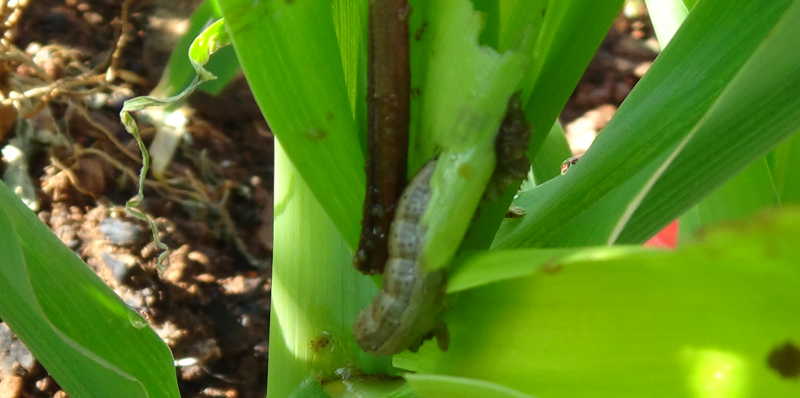Updated Background: Fall Army Worm Outbreak in Eastern and Southern Africa
Nature and scale of outbreak.
According to the World Bank, the outbreak of Fall Armyworm (FAW) first emerged in Africa in 2016 and has spread to several countries. The pest was first detected in Nigeria in 2016 and later within Southern Africa in Zambia. It has subsequently spread rapidly in the southern and Central Africa region. In its adult moth stage the Fall Armyworm can travel significant distances and can also be transported in grain. The pest likely spread to Africa from the Americas where it has been present in sub-tropical and tropical areas for several decades. The lack of natural predators may have led to the initial explosive growth in the region. Crop losses can be substantial where infestation occurs.
Fall Armyworm has a preference for maize but can affect a wide range of plant species such as sorghum, sugarcane, cotton, Irish potato, tomato, tobacco, sweet potato, common bean, cowpea, soybean, groundnut and also targets livestock grazing pastures. It has the potential to remain active and cause damage throughout the year. Strengthening efforts to control fall army worm is important for the next season given the risk of greater pest multiplication. Irrigation/winter cropping is also expected to provide a conducive environment for the pest and there is a risk of continued build up of the FAW population.
Options for control include:
- Chemical: Synthetic pyrethroids/insecticides have been effective at controlling infestations, however according to CIMMYT, extensive use of synthetic insecticides in South America to control Fall Army worm led to development of resistance to all classes of insecticides. Sole reliance on insecticides for control is considered unsustainable. The table below contains information on FAW recommended pesticides.
- Germplasm with resistance: Some varieties of maize may have natural resistance, particularly those already bred for resistance for grain borers. More research is required but CIMMYT indicates germplasm with resistance may be available globally that could be used in breeding programs. CIMMYT also indicates that a GMO Bt Maize variety may have resistance but this is not a viable option given the current biosafety framework in many countries. CIMMYT may undertake confined field trials in Tanzania through its Water Efficient Maize for Africa (WEMA) Project but it is not yet approved.
- Biological control: According to CIMMYT alternatives to synthetic insecticides include natural biological control (predators, parasitoids and entomopathogens), use of bio-rationals (pheromone trapping, attract-and-kill) and bio-pesticides (including Bt sprays). All have been shown to be effective in managing FAW damage in the Americas.
- Agronomic management: Field experience in Africa seems indicate pest incidence was reduced by: early planting; diversification of the plot and landscape with trees and hedgerows; integration of intercrops in pure maize stands; and land-use. These practices appear to work by increasing the population of predators and natural enemies (spiders, wasps birds, bats), repelling the moths and preventing release of eggs, or allowing grain to from before caterpillars emerge.
Fall Army Worm Information Resources
CIMMYT: Fall Armyworm factsheet:
CABI: Fall Armyworm Overview
Updated March 2017 with good overview and detailed bibliography of academic literature and insect control guidelines http://www.cabi.org/isc/datasheet/29810
Agriculture Research Council of South Africa – Fall Army Worm Factsheet: http://www.arc.agric.za/Documents/BannerPdfs/The%20new%20Invasive%20Fall%20Armyworm%20(FAW)%20in%20South%20Africa.pdf
Grain SA – website on FAW http://www.grainsa.co.za/pages/news/fall-armyworm-update
DAFF approved pesticide list for Fall Armyworm control as of March 17, 2017
Crop Life South Africa – Detection, identification and management protocol (Version 4, March 2017)
http://www.croplife.co.za/images/CLSA_FAW_position_statement_Version_5_8_March_2017.pdf
Crop Life South Africa – Agricultural Remedies Database
Application guidelines by chemical/crop: http://www.croplife.co.za/index.php/croplife-sa-initiatives?layout=edit&id=15
Department of Agriculture (DAFF) – Tools to guide the control of Fall armyworm in South Africa
USA – USDA and State Extension Resources
Virginia Cooperative Extension: Pest Management Guide 2017 https://www.pubs.ext.vt.edu/content/dam/pubs_ext_vt_edu/456/456-016/456-016-17-Field-Crops.pdf
Virginia Cooperative Extension: Fall Armyworm in Vegetable Crops: https://www.pubs.ext.vt.edu/content/dam/pubs_ext_vt_edu/444/444-015/444-015_pdf.pdf
Purdue – Fall Armyworm factsheet: https://extension.entm.purdue.edu/fieldcropsipm/insects/fall-armyworm.php
Purdue – Corn Insect Control Guidelines: https://extension.entm.purdue.edu/publications/E-219.pdf

